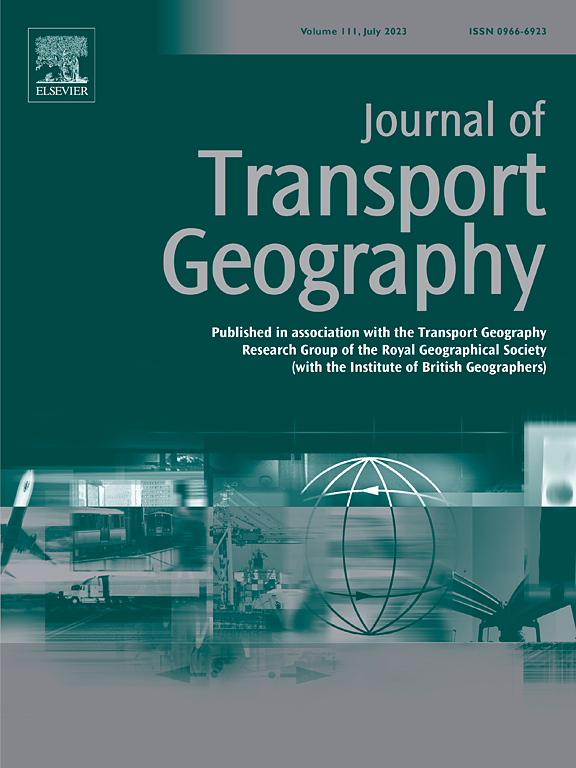How does the spatial scale impact accessibility analysis and equity? The case of accessibility to supermarkets in Montreal
IF 6.3
2区 工程技术
Q1 ECONOMICS
引用次数: 0
Abstract
In place-based accessibility analyses, larger spatial scales, such as census tracts or traffic analysis zones, are often chosen for their practicality and ease of data management. However, larger spatial scales can introduce errors or biases, a phenomenon commonly known as the Modifiable Areal Unit Problem (MAUP). Although MAUP has been addressed in accessibility studies, most compare biases between larger spatial scales and do not use building lots as the reference unit. In this paper, we consider building lots to be the smallest unit of analysis for transport and urban planning. Those that do often fail to estimate the direction and magnitude of overestimation or underestimation or quantify and identify which population groups are most affected. This paper addresses this gap by quantifying the misestimation of accessibility to supermarkets in Montreal, using the cumulative opportunities measure and time to the nearest amenity, by comparing residential building lots with dissemination blocks, dissemination areas, and census tracts. We also measured the cumulative opportunities using three spatial approaches: centroid-to-centroid within census geographies, centroid-to-amenity, and average accessibility. We found that the larger the spatial scale, the higher the misestimation. Census tracts (CTs), the larger spatial scale, show a mean overestimation of 132 % to 154 %, dissemination areas (DAs) range from 111 % to 136 %, and dissemination blocks (DBs) range from 99 % to 131 %. Overestimation affects 14–54 % of dwellings in census tracts, 9–47 % in dissemination areas, and 5–46 % in dissemination blocks, depending on the mode of transport. The centroid-to-amenity generally performs the best in terms of misestimation, and we found mixed results across income groups. These findings can inform decision-makers about the importance of using small spatial scales and optimal approaches to minimize bias and improve city resource allocation.
空间尺度如何影响可达性分析和公平性?以蒙特利尔的超市为例
在基于地点的可达性分析中,通常选择较大的空间尺度,如人口普查区或交通分析区,因为它们具有实用性和易于数据管理。然而,较大的空间尺度可能会引入误差或偏差,这种现象通常被称为可修改面积单位问题(MAUP)。虽然MAUP已经在可达性研究中得到了解决,但大多数在更大的空间尺度上比较偏差,并且不使用建筑地块作为参考单位。在本文中,我们将建筑地块作为交通和城市规划分析的最小单位。那些这样做的人往往无法估计高估或低估的方向和程度,也无法量化和确定哪些人口群体受影响最大。本文通过将住宅楼地块与分布街区、分布区域和人口普查区进行比较,利用累积机会测量和距离最近的便利设施的时间,量化了对蒙特利尔超市可达性的错误估计,从而解决了这一差距。我们还使用三种空间方法测量了累积机会:人口普查区域内的质心到质心、质心到舒适设施和平均可达性。我们发现,空间尺度越大,错误估计越高。在较大的空间尺度上,人口普查区(CTs)的平均高估幅度为132%至154%,传播区(da)的平均高估幅度为111%至136%,传播区(db)的平均高估幅度为99%至131%。根据交通方式的不同,高估影响了人口普查区14 - 54%的住房,分布地区9 - 47%的住房,分布街区5 - 46%的住房。在错误估计方面,质心到舒适度的表现通常是最好的,我们发现不同收入群体的结果好坏参半。这些发现可以让决策者了解利用小空间尺度和最佳方法来减少偏见和改善城市资源配置的重要性。
本文章由计算机程序翻译,如有差异,请以英文原文为准。
求助全文
约1分钟内获得全文
求助全文
来源期刊

Journal of Transport Geography
Multiple-
CiteScore
11.50
自引率
11.50%
发文量
197
期刊介绍:
A major resurgence has occurred in transport geography in the wake of political and policy changes, huge transport infrastructure projects and responses to urban traffic congestion. The Journal of Transport Geography provides a central focus for developments in this rapidly expanding sub-discipline.
 求助内容:
求助内容: 应助结果提醒方式:
应助结果提醒方式:


